#The Farmer Project 2008
Explore tagged Tumblr posts
Text


















Mylène Farmer in The Farmer Project (2008)
#french#gifset#my gifs#french side of tumblr#mylène farmer#The Farmer Project 2008#french singer#sci fi#Dégénération#Si J'avais Au Moins
13 notes
·
View notes
Text
Good News - May 22-28
Like these weekly compilations? Support me on Ko-fi or $Kaybarr1735! Also, if you tip me on Ko-fi or CashApp (and give me some way to contact you if it doesn’t automatically), at the end of the month I'll send you a link to all of the articles I found but didn't use each week - almost double the content!
1. Scientists Invent Healthier More Sustainable Chocolate
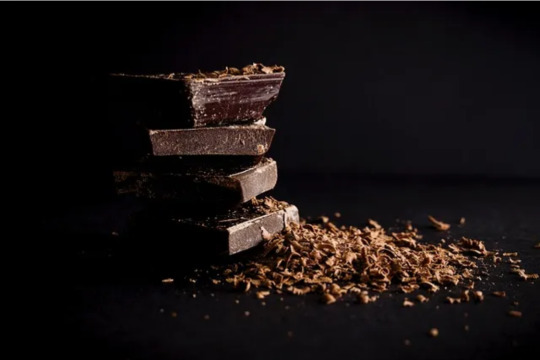
“The new chocolate recipe from researchers at ETH Zurich uses more materials from the cocoa pod that are usually discarded, including more of the pulp as well as the inner lining of the husk, known as the endocarp. […] The resulting chocolate also [was “deliciously sweet” and] had 20% more fibre and 30 percent less saturated fat than average European dark chocolate[, and] it could enable cocoa farmers [to] earn more from their crops.”
2. Vermont Is Coming for Big Oil, Making It Pay for Decades of Climate Pollution

“Legislators in Montpelier are on the brink of enacting the "Climate Superfund Act," modeled after the federal Superfund law, that seeks to make oil, gas and coal companies pay for damages linked to historical greenhouse gas emissions. […] Companies would be held liable for the costs associated with […] floods and heat waves, along with losses to biodiversity, safety, economic development and anything else the treasurer deems reasonable[, that were caused by their emissions].”
3. Important bird habitat now protected in the Rocky Mountain Trench
“Grassland-reliant species in the Rocky Mountain Trench now have more protected habitat thanks to a new [270-hectare] conservation area near Cranbrook. […] About one-third of the Skookumchuck Prairie Conservation Area is forested[…,] Most of the site is a dry grassland[…, and] Three hectares of wetlands add to the landscape diversity and offer crucial benefits to wildlife and water systems in the area. This conservation gem also provides habitat for endangered American badger and excellent winter range for elk, mule deer and white-tailed deer.”
4. Lemur Week marked by 70th breeding success
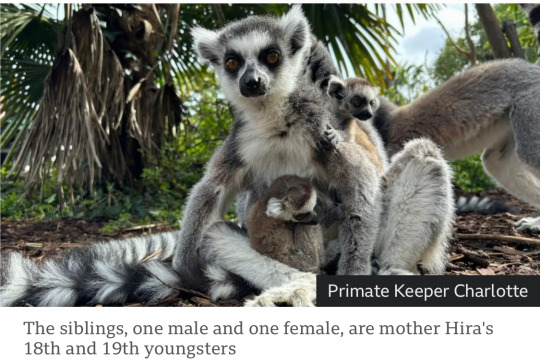
“A wildlife park has celebrated its 70th lemur breeding success ahead of a week raising money to help save the endangered primates. […] The park's open-air Madagascar exhibit is home to 31 free-roaming lemurs and was officially opened in 2008. […] Females are only sexually receptive for just one or two days a year, leaving a small window of opportunity for males to father offspring. […] The two playful siblings, one female and one male, were born to father Bernard and mother Hira.”
5. Innovative material for sustainable building
“Researchers introduce a polymer-based material with unique properties. This material allows sunlight to enter, maintains a more comfortable indoor climate without additional energy, and cleans itself like a lotus leaf. The new development could replace glass components in walls and roofs in the future.”
6. Isle of Wight eagles don't pose threat to lambs as feared

“While there had previously been fears that the eagles would feed on livestock, such as lambs, the project has found no evidence of this. [… “W]hite-tailed eagles effectively steal meals from other predatory birds[, which is] a really important ecological role that had been lost within the landscape and is being restored.” [… The birds’] population was boosted by a chick last year – the first time the species has bred in England in 240 years.”
7. Breakthrough discovery uses engineered surfaces to shed heat
“Cheng's team has found a way to lower the starting point of the [Leidenfrost] effect by producing a surface covered with micropillars. […] The discovery has great potential in heat transfer applications such as the cooling of industrial machines and surface fouling cleaning for heat exchangers. It also could help prevent damage and even disaster to nuclear machinery.”
8. New malaria vaccine delivered for the first time
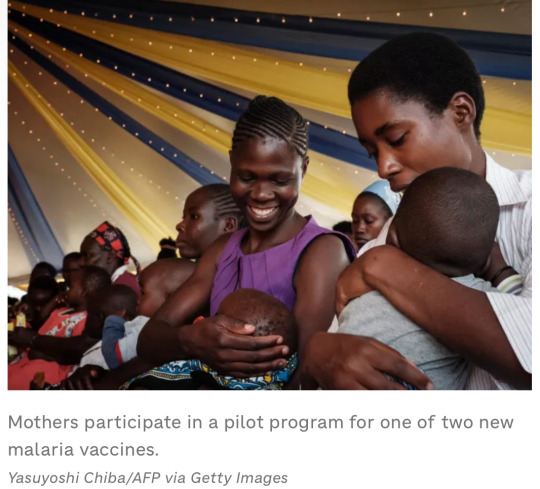
“A total of 43,000 doses arrived by air today from UNICEF, and another 120,000 are scheduled to show up in the coming days. […] They're the first vaccines designed to work against a human parasite. […] Across four African countries, these trials showed a 75% reduction in malaria cases in the year following vaccination of young children. […] The Serum Institute of India, who will be manufacturing the new vaccine, says a hundred million doses will likely be available to countries by the middle of next year.”
9. Urban gardening may improve human health: Microbial exposure boosts immune system
“"One month of urban indoor gardening boosted the diversity of bacteria on the skin of the subjects and was associated with higher levels of anti-inflammatory cytokines in the blood. The group studied used a growing medium with high microbial diversity emulating the forest soil," [… whereas] the control group used a microbially poor peat-based medium. [… N]o changes in the blood or the skin microbiota were seen. […] “This is the first time we can demonstrate that meaningful and natural human activity can increase the diversity of the microbiota of healthy adults and, at the same time, contribute to the regulation of the immune system."”
10. Cities Are Switching to Electric Vehicles Faster Than Individuals

“[M]ost large cities have adopted some kind of climate goal, and some of them are buying EVs for their municipal fleets at a faster rate than the general public. And that progress could speed up as more EVs enter the market and as cities get educated about grant funding and tax incentives that were passed over the last four years.”
May 15-21 news here | (all credit for images and written material can be found at the source linked; I don’t claim credit for anything but curating.)
#hopepunk#good news#chocolate#sustainability#farming#health#vermont#big oil#oil companies#climate change#cooling#technology#nuclear#malaria#vaccine#africa#unicef#eagles#livestock#england#birds#electric vehicles#glass#energy efficiency#habitat#conservation#lemur#zoo#gardening#urban gardening
352 notes
·
View notes
Text
MCU Timeline: Avengers: Age of Ultron
19th century - Black Panther kills Ulysses Klaue's great-grandfather during his attempt to annex Wakanda.

1990s - Wanda and Pietro Maximoff are born (12 minutes apart).
Between 1992 and 2008 - Tony meets Ulysses Klaue at an arms convention, before Klaue got his tattoos and branding.
~2000 - the Maximoff twins become orphans. They remain trapped with the unexploded shell for 2 days.


May 4/5, 2012 - STRIKE hands the Scepter over to Dr. List.
Early 2014 - Maximoffs volunteer for Hydra's experiments and become mutants.
Spring 2014 - Spring 2015:
The Avengers become Tony's private paramilitary organization under Cap's command.
The team moves in the Avengers Tower.
September/October 2014 - Clint is on vacation.
Tony creates the Iron Legion.
Tony and Bruce create Veronica and Hulkbuster.
The Avengers raid Hydra bases in search of the Scepter.

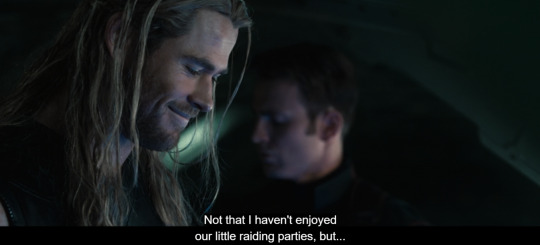
The main events take place in early or mid-April 2015.
Day 1 (Thursday), April 2nd or 9th:
Afternoon in Sokovia - The Avengers attack the local Hydra base.

3 pm in NY (several hours later) - they return to Avengers Tower. Clint is being treated by Dr. Cho.

Evening - Tony convinces Bruce to use the Scepter to try to create a global peacekeeping AI, Ulton.
Day 1-3 (Thursday-Saturday), April 2-4 or 9-11 - Tony and Bruce work on Project Ultron.
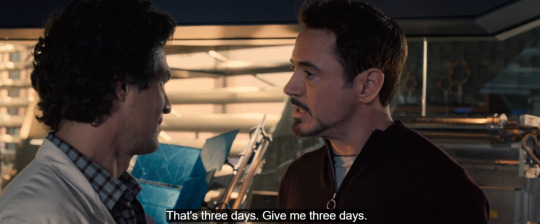
Day 3 (Saturday), April 4th or 11th:
Evening - the birth of Ultron.
The farewell party.


Night - Ultron's attack on Avengers Tower.
Day 4 (Sunday), April 5th or 12th:
Early morning in Sokovia - Ultron takes the Scepter, goes online, and, after connecting to Strucker's castle in Sokovia, begins creating a new body and many Ultron Juniors.
The Avengers discuss the situation.
Days 4-8, April 5-9 or 12-16:
Ultron builds his body.
Maximoff twins join him.
Ultron and the twins are emptying laboratories and weapon facilities.
Ultron tries to get his hands on the nuclear codes, but J.A.R.V.I.S. holds the line.
The Avengers try to find him and find out his plans.
Rhodey returns to his duties in the Air Force.
Thor tries to reach Heimdall, to no avail.
Ultron kills Strucker.
Day 8 (Thursday), April 9th or 16th:
3:30 - 5:40 pm - the Avengers learn of Strucker's death and finally track down Ultron, which leads them to Ulysses Klaue.

Note: It's always Thursday on computers in this movie. It's highly doubtful that this is true for all of them, and is most likely just a result of the laziness of whoever was in charge of the screens. I'll accept this as true for the first appearance only, since it also makes sense for the number of days that have passed.
Rhodey heads to the Middle East. Tony updates War Machine's encryption against Ultron's cyber attacks.
~Day 9 (Friday), April 10th or 17th:
Afternoon in South Africa - The Battle at the Salvage Yard.
Evening in Africa/Morning in the US - The Duel of Johannesburg.

Night in Africa/Day in the US - the team is on their way to Barton's farm.

Afternoon - team arrives at Barton's farm. Thor departs to London. Fury sits in ambush in Clint's barn.
Evening - Bartons and Co are having dinner. Fury gives the Avengers a pep talk.
~Day 10 (Saturday), April 11th or 18th:
8 pm in Korea/6 am in the US - Ultron takes control of Helen Cho and her Cradle in Seoul.

6 am in the US - the Farmers Avengers split up: Tony heads to the Nexus facility in Oslo; Rogers, Barton, and Romanoff head to Seoul; Fury drops Banner off at the Tower, picks up Hill and Rhodes, and then goes to dust off the original Helicarrier.

Night in Korea/Morning in the US - Ultron and Doctor Cho work on Ultron's new vibranium-organic body.
Afternoon in Oslo/Morning in the US - Tony retrieves what's left of JARVIS from the net.
Afternoon in London/Morning in the US - at the University of London, Thor picks up Erik Selvig and takes him to the Water of Sight.
Afternoon in the US - Tony restores JARVIS.
Morning in Seoul/Evening in the US - Ultron begins uploading himself into the new body. The twins learn of his plan, remove his control from Dr. Cho, and escape.
The Battle of Seoul.
The twins join the Avengers. Ultron takes Natasha to his castle in Sokovia. Clint brings the Cradle to Tony and Bruce.
Night in NY - Natasha wakes up in the castle. Ultron creates a new body out of vibranium. Tony and Bruce work on Vision. Clint connects with Nat.

Note: on this computer screen it's Thursday (again) and 3:28 PM, which obviously doesn't match the time in the movie. It's night there, so we have to ignore this unreliable evidence for both the day of the week and the time.
The birth of Vision.

The Avengers prepare to battle Ultron. Tony chooses FRIDAY as his new main AI.

~Day 11 (Sunday), April 12th or 19th:
6 am (local) - the Avengers arrive in Sokovia and evacuate the city.

7 am - the Battle of Sokovia.
Tony and Thor save Earth from the artificial meteorite. Pietro dies saving Clint. Vision kills Ultron. Hulk takes the Quinjet and leaves the planet.

Evening in the US - Clint comes home.
April - September 2015:
Barton retires.
Tony builds a new Avengers Compound in upstate New York.
~June 2015 - Nathaniel Pietro Barton is born.

Note: babies usually start giggling around 4 months of age. At the time of the main events, he was about 2 months away from being born, then add about 4 months to that Compound scene.
September 2015:
The new team has been assembled, now including Wanda, Rhodey, Sam and Vision.
Fury, Hill, Cho and Selvig work at the Avengers Compound.
After making sure that the team is assembled, the Compound is built and everything is ok, Tony tries to retire. Again.
Thor goes to investigate the situation with the Infinity Stones.

Note: I take it the makeup artists thought this scene took place right after the Battle of Sokovia? That's why Thor still has scratches on his face. But as practice shows, children are not born and do not grow up so quickly (see the previous note), so we will have to accept the fact that Thor has already managed to fight with someone again.
Forever - Clint Barton lives.

MCU Phase One Timelines Iron Man 3 Timeline Thor: The Dark World Timeline CA:TWS Timeline GotG Timeline
#marvel#mcu#tony stark#iron man#avengers#avengers age of ultron#steve rogers#captain america#mcu timeline#clint barton#hawkeye#natasha romanoff#black widow#thor#hulk#bruce banner#wanda maximoff#pietro maximoff#ultron
105 notes
·
View notes
Text






─ •✧ WILLIAM'S YEAR IN REVIEW : 𝐌𝐀𝐘 ✧• ─

𝟏 𝐌𝐀𝐘 : The Prince of Wales received Mr. Simon Patterson (Vice Chairman, The Royal Foundation) at Windsor. William supported Fields in Trust's #BarkForOurPark Campaign. 𝟐 𝐌𝐀𝐘 : He attended the UEFA Conference League Semi-Final first leg match between Aston Villa & Olympiakos at Villa Park. 𝟕 𝐌𝐀𝐘 : William received the Lord Janvrin (Chairman, The Queen Elizabeth Memorial Committee) at Windsor Castle. He received the Lord Hague of Richmond (Chairman, The Royal Foundation) at Windsor Castle. 𝟖 𝐌𝐀𝐘 : William held an Investiture at Windsor Castle. 𝟗 𝐌𝐀𝐘 : The Duke of Cornwall started his two-day tour of the Duchy of Cornwall. He spent the day in Newquay and was received by His Majesty's Lord-Lieutenant of Cornwall (Colonel Sir Edward Bolitho) at the site of the new Nansledan Housing Project. Afterwards, he met lifeguards and volunteers of the Royal National Lifeboat Institution at Fistral Beach. He met representatives of the Hollywell Bay & Newquay Surf Life Saving Clubs. Later, he arrived at St Agnes in the Isles of Scilly where he visted Troytown Farms & spent time with the community during a picnic. 𝟏𝟎 𝐌𝐀𝐘 : William spent the day in Isles of Scilly. He was received by Mrs. Jane Hartley (Deputy Lieutenant of Cornwall) at the Quay, St. Mary's. He visited St. Mary's Harbour and met crew from the 2024 World Pilot Gig Championships. Later, he visited St. Mary's Hospital in Belmont. The Duke of Cornwall also privately took part in a nature walk with Isles of Scilly Wildlife Trust. 𝟏𝟏 𝐌𝐀𝐘 : He appeared in a video message during the Steve Irwin Gala. 𝟏𝟐 𝐌𝐀𝐘 : William appeared in a video message during BAFTA TV Awards. He sent out a tweet congratulating Manchester United WFC on their Vitality FA Cup Win. 𝟏𝟑 𝐌𝐀𝐘 : The Prince of Wales was officially appointed as the Colonel-in-Chief of the Army Air Corps by King Charles III. Subsequently, he visited the Army Air Corps at the Army Aviation Centre. Kensington Palace released two unseen photos from 1999 and 2008 featuring William to mark the occasion. 𝟏𝟓 𝐌𝐀𝐘 : William released a personal tweet congratulating Aston Villa for their Champions League qualification. 𝟏𝟔 𝐌𝐀𝐘 : William attended "World Together Solving the Antibiotic Emergency" Conference at the Royal Society and was received by Deputy Lieutenant of Greater London (Reverend Canon Dr. Flora Winfield). Later in the evening he hosted a Reception at St. James's Palace. William also appeared in a video message to mark the 10th anniversary of the Elephant Initiative. 𝟏𝟕 𝐌𝐀𝐘 : Kensington Palace marked Mental Health Awareness Week via social media. Additionally, the Duchy of Cornwall unveiled funding plans of the Duchy Mental Health Strategy providing their farmers with access to support. 𝟐𝟏 𝐌𝐀𝐘 : The Prince of Wales received Major General James Bowder (General Officer Commanding London District and Major General Household Division, Welsh Guards). In the afternoon, he hosted a garden party at Buckingham Palace. 𝟐𝟐 𝐌𝐀𝐘 : William held an Investiture at Windsor Castle. 𝟐𝟓 𝐌𝐀𝐘 : William and Catherine released a personal tweet offering condolences on the passing of an RAF pilot at RAF Coningsby. William and George attended the Emirates FA Cup Final between Manchester City Football Club and Manchester United Football Club at Wembley Stadium. He also send out congratulations via a tweet. 𝟐𝟕 𝐌𝐀𝐘 : William and Catherine sent a letter to Tracey Morris offering condolences for her husband, Peter's death. 𝟐𝟖 𝐌𝐀𝐘 : William and Catherine were out shopping at a deli in Holt, Norfolk.

#review 2024#year in review : william#year in review : 2024#year in review 2024 : may#william review : may#review may#year in review 2024 : william#prince of wales#the prince of wales#prince william#william prince of wales#brf#british royal family#british royals#royalty#royals#royal#british royalty#royaltyedit#royalty edit#my photoset#will edit#13052024#king charles iii#king charles lll#photoset#princess of wales#the princess of wales#princess catherine#princess kate
48 notes
·
View notes
Text
With hundreds of highly prized species, bird tourism is thriving in the country – and farmers are increasingly turning their land into nature reserves
“Wildlife tourism is far more profitable than farming but that’s not the only reason we made the change,” says Ajila’s son, Luis Jr. “We wanted to save not just the umbrellabird, but all the special creatures here, and safeguard them for future generations.”
Projects such as this are eligible for funding from the Ecuadorian government. Launched in 2008, the Socio Bosque scheme offers “the poorest private and communal forest landowners annual payments for each hectare of forest cover maintained”, with sums of between $30 (£23) and $60 a hectare.

The Ajila family: Luis Jr, Alejandra and Luis Sr. Photograph: Dr Stephen Moss
But the income provided by birders alone has been enough to propel some farmers to take up the nature reserve model.A few years ago, Favián Luna decided to convert his 120-hectare tomato farm in the Tandayapa Valley, north-west of Quito, into a cloud-forest reserve and lodge called Alambi Reserve. Visitors go to photograph many species of hummingbirds, including the Andean emerald, native to the Chocó bioregion of the Ecuadorian Andes.
Nearby, at Mashpi Amagusa, former farmers Doris Villalbaand Sergio Basantes have created a reserve, lodge and garden, which attracts 260 species of sought-after birds. Highlights include glistening-green, flame-faced and beryl-spangled tanagers, and the rare, endemic rose-faced parrot.
At Finca La Victoriana in Pichincha, the owner Jacqui bought the house and land, and began to reforest the site while growing crops to feed herself. But during lockdown, when she was stuck in nearby Quito, all her crops were stolen. She was saved from having to sell up by a visiting friend, who heard an unusual sound from lower down the valley and realised this was one of South America’s most charismatic birds: the Andean cock-of-the-rock.

Male Andean cocks-of-the-rock (Rupicola peruvianus) lekking to attract a mate. Photograph: Jiri Hrebicek/Alamy
Since 2005, Ángel Paz and his younger brother Rodrigo have transformed their former dairy farm in Mindo into a bird reserve. At first, things didn’t go to plan: it took a month for the first visitor to arrive, and he paid just $10 for a four-hour tour. Since then, however, thousands of people have made the pilgrimage.
#solarpunk#solar punk#indigenous knowledge#solarpunk aesthetic#informal economy#farms#wildlife#bird sanctuary#bird reserve#ecuador#south america
18 notes
·
View notes
Text

Grown In Detroit Takes Off
Detroit’s urban farm movement entered a new phase in 2005, when the Garden Resource Program started helping urban farmers begin to market their produce. By 2008, 47 gardens were participating in the Grown In Detroit Cooperative, marketing their produce at seven sites around the city, including the city’s old and wonderful farmer’s market, the Detroit Eastern Market. In the co-op, experienced marketers help show newer sellers the ropes, educating them about quality standards, packaging, pricing, etc.. As a result, in 2008 the Grown In Detroit Cooperative had gross sales of $14,668, with 100% of the profits going back to the local gardens and gardeners involved.
Last season the Grown In Detroit Cooperative initiated a program to involve and train young urban farmers. This program, called Youth Growing Detroit, developed seven different groups consisting of 61 young people and 11 adult leaders. The young people involved not only helped produce the crops that were taken to market, they also helped staff the Grown In Detroit tables on market days. In addition, they participated in two summits in the spring to exchange ideas, tour each other’s gardens, make plans for marketing produce, etc. And, on market days, in addition to learning marketing and record-keeping skills, the young farmers also earned a small stipend for their hours invested.
A Compost Workgroup within the GRP has been focusing on developing a community composting pilot project to demonstrate an open-pile composting system scaled appropriately for community gardens. And, as of last year, a Seed Saving Project was initiated to increase the proportion of seeds grown locally for distribution to community gardeners. In addition, the GRP offers training classes and resources on a wide range of topics from extended-season growing to urban beekeeping. Finally, through its 9-week Urban Roots training course, the GRP trains participants both in horticulture and community organizing to provide them with the skills necessary to help build the developing urban farm movement in new neighborhoods.
#grown in detroit#gid#small farms#urban gardening#urban farming#detroit#solarpunk#small farm movement#community building#practical anarchy#practical anarchism#anarchist society#practical#revolution#anarchism#daily posts#communism#anti capitalist#anti capitalism#late stage capitalism#organization#grassroots#grass roots#anarchists#libraries#leftism#social issues#economy#economics#climate change
13 notes
·
View notes
Text
野鳥調査を通じたタジャン農家とインドネシア農家の交流プログラム 1日目
みなさんこんに��は。CGNインターンのKurumiです。
今回は2/9〜2/15にかけて、インドネシアから5人の農家の方々が、CGNの事業地であるタジャンを訪れ、交流プログラムを行ったのでそのことについて、感想を書いていきたいと思います。
まずこのプログラムは、「野鳥がつなぐアジアの持続可能なコーヒー ~野鳥を指標とした環境評価手法による東南アジア2国の持続可能なコーヒー推進事業~」(トヨタ財団環境助成)というプロジェクトタイトルの元、フィリピンとインドネシアのアグロフォレストリーでコーヒー栽培を行なっている地域で野鳥を調査することで、野鳥を指標とした環境評価の導入、アグロフォレストリーにおける環境保全の指針作成、環境に配慮したサステイナブルコーヒーに関心のある消費者への販売につなげることを目的としたプロジェクトです。
日本からは野鳥調査のプロであるNPO法人バードリサーチJapan Bird Associationのメンバー3名、インドネシアからはKlasik Beans Cooperativeから5名が訪れました。
Klasik Beans Cooperativeは、インドネシア、ジャワ島を拠点とするコーヒー農家の組合です。2008年に創設され、コーヒーの栽培指導や小規模加工施設の設置と運営から今ではマーケティングまで行い、環境保護を考慮して作られた質の良いコーヒーを国内外へ販売しています。これまでにも2度創設者のエコさんに実際にCGNに指導しに来てもらったこともありますが、今回は新しく5人の若い農家の方が来てくれました。
ここでは、まずインドネシアからの一行が到着した1日目の様子をレポートします。

*スケッチブックに書いた手作り感満載のウェルカムボード。

*マニラ空港でコーヒーを飲みながら自己紹介。左からアンドリ、まりこさん、ウデン、マリアム、ゼナ、私、センディ。
無事にインドネシアチームとも合流でき、その後5時間かけてバギオへと向かいます。初めてのフィリピンで、新鮮な反応をしているインドネシアチームのみんなを見て、自分が初めてフィリピンに来た時のことを思い出して懐かしくなりました。
ケノンロードのジグザグ道を上り、バギオの入口にあるLion’s Headで少し観光したのち、昼食を食べ(Ebais Cafe)、宿泊先にチェックイン(Eco Lodge)し、CGNのオフィス���向かいました。オフィスではCGNのコーヒーを出しているNest Coffee Roastersのコーヒーを飲みながら、まりこさんによるCGNの団体説明。

*Lion's Head。私も初めて見ましたが、すごくダイナミックで多くのフィリピン人観光客で賑わっていました!

*オフィスでまりこさんがCGNについての説明をしている場面。インドネシアとの共通点なども見つかり有意義な時間!
また、ちょうどフィリピンの主にパンガシナン州で活動している埼玉県ふじみ野市の市民団体Kumusta ka LINK(クムスタカ・リンク)の方々がCGNのコーヒー事業地を1日ツアーで訪れていて、バギオを出発前にオフィスに寄ってくれた際に、ご挨拶することもできました。クムスタカ・リンクの方たちは、CGNのリリーさんの案内でトゥブライ町の生産者を訪ねたとのことで、コーヒーの収穫から加工・焙煎・試飲までの一通りの工程を初めて体験し、非常に楽しんだ様子が伝わってきました!
この時点ですっかり日も暮れていて、CGN事務所を出て急いで夕食へ(Oh My Gulay)。ベジタリアンフードを楽しんだあと、私はインドネシアチームのみんなとお別れし、帰宅しました。みんなはさらにモールへ行き夜景を見てからロッジに戻ったそうで、インドネシアチームの体力に驚きました笑。
次の日はいよいよタジャンへ移動する日です!が、移動する前にバギオでカッピング体験もしたのでお楽しみに〜

*ジープ(フィリピンの代表的な乗り合いタクシー)内での様子。みんなジープに興味津々で、デザインがとにかく気に入ったみたいで写真を撮りまくっていました笑。
Exchange program between farmers in Tadian and Indonesia through bird surveys - Day 1
Hello everyone, I’m Kurumi.
From February 9th to 15th, an exchange program took place where five coffee farmers from Indonesia visited Tadian, one of CGN’s project sites.
This program is a part of the project titled “Sustainable Coffee in Asia Connected by Migratory Birds - A Project to Promote Sustainable Coffee in Two Southeast Asian Countries by Environmental Assessment Methods Using Birds as Indicators.(Toyota Foundation Environmental Grant)” This project aims to introduce an environmental assessment method using birds as an indicator, draft guidelines for forest conservation in agroforestry and to promote sustainably cultivated coffee to environmentally conscious consumers.
From Japan, three bird researchers from Japan Bird Research Association joined the survey while five coffee growers from Klasik Beans Cooperative came from Indonesia.
Klasik Beans Cooperative is an organization of coffee farmers based in Java, Indonesia, established in 2008. They provide guidance on coffee cultivation, establish and operate small-scale processing facilities, and now even engage in marketing. Their high- quality, truly environmentally friendly coffee is exported nationwide and worldwide. Before, Eco, the founder of Klasil Beans, visited CGN to share their expertise, but this time, five young farmers participated in the exchange.
Now, let’s dive into the details of Day 1.
The Indonesian team arrived at Manila international airport on February 9th early in the morning, so I picked them up from Baguio by van. I met Mariko san there and held a welcome board for the first time.
After meeting up, we took a five- hour van ride to Baguio. It was their first time in the Philippines, and seeing their reactions reminded me of when I first came here
Upon arriving in Baguio, we did sightseeing at the Lion’s Head, had lunch(Ebais Cafe), and checked into their lodge(Eco Lodge). After a short break, we headed to our office and Nest Roasters Coffee served coffees to them that used CGN’s coffee. While enjoying the coffee, Mariko san introduced CGN’s activities. The discussion was insightful, as we found many similarities between Indonesia and the Philippines and shared our experiences.
Coincidentally, a Japanese organization called Kumusta ka LINK, which supports Filipino communities, was also visiting CGN’s coffee project site that day. Before leaving Baguio, they stopped by our office, and we had the chance to greet each other. It was shared that, guided by Lily from CGN, they visited coffee producers in Tublay. They seemed very excited, as it was their first time experiencing the entire coffee process—from harvesting to processing, roasting, and tasting.
By the time we finished, it was already dark outside. We quickly headed out for dinner and enjoyed some vegetarian food there(Oh My Gulay). After saying goodbye to them, I returned home, but they still had enough energy to visit a mall and admire the night view. Their stamina really surprised me!
That’s all for Day 1! The next day, we’ll be heading to Tadian, but before that, we also had a cupping session in Baguio. See you in the next blog!
2 notes
·
View notes
Text

The Emperor's New Groove (2000, Mark Dindal)
17/01/2024
The Emperor's New Groove is a 2000 animated film directed by Mark Dindal.
It is the 40th Disney classic, and began as an epic musical called Kingdom of the Sun with directors Dindal and Roger Allers, but over the course of its six years of production it was transformed by Disney executives into a light buddy comedy about Kuzco, a young and selfish Inca emperor who, mistakenly transformed into a llama by his former advisor Yzma in an attempt to poison him, tries to regain his human form aided by the generous farmer Pacha, who teaches him to be altruistic.
The film, shown for the first time in the United States on December 15, 2000, was not a great financial success but received generally positive reviews, being considered one of the best films of Disney's post-Renaissance era and being nominated for an Academy Award for Best song for My Funny Friend and Me, performed by Sting.
However, the film achieved greater success and notoriety from the public later, thanks to excellent sales on the home-video market, and had a sequel and direct-to-video spin-off entitled Kronk's New Groove (2005) and an animated television series entitled The Emperor's New School (2006-2008).
Kuzco, a spoiled, selfish and arrogant young Inca emperor, intends to build, as a birthday present, a new holiday home with a swimming pool called Kuzcotopia on the top of a hill, at the price of destroying an entire village of farmers. Due to the naivety of Kronk, Yzma's aide, a potion is poured into the glass from which the emperor drinks that transforms him into a llama.
The emperor ventures into the jungle alone, coming across a pack of black jaguars; saved at the last minute by Pacha, Kuzco accepts the latter's conditions to be able to return to the palace.
Meanwhile, Yzma celebrates the emperor's funeral and is proclaimed empress; while she toasts with Kronk to her success, the latter lets slip that the emperor is still alive, so the two leave together to look for him.
Kuzco: protagonist of the story, he is the emperor of the Inca Empire.
The idea for Kingdom of the Sun was conceived by Roger Allers and Matthew Jacobs, and development of the project began in 1994. When pitching the project to Disney's then-CEO and president Michael Eisner, the latter said that "it has all the elements of a classic Disney film", and thanks to his success as director of The Lion King that same year, Eisner gave Allers carte blanche with both casting and plot. In January 1995 Variety reported that Allers was working on "an original Incan-themed story".
In 1996 the production team took a trip to Machu Picchu, Peru, to study Inca artifacts and architecture and the landscape in which this empire was created.
Kingdom of the Sun was supposed to be the story of a greedy, selfish emperor (voiced by David Spade) who finds a farmer who looks just like him (voiced by Owen Wilson); the emperor trades places with the peasant for fun, just as in Mark Twain's archetypal novel The Prince and the Pauper. However, the evil witch Yzma plans to summon the evil god Supay and capture the sun so she can stay young forever (the sun gives her wrinkles, so she speculates that living in a world of darkness would prevent her from aging).
#the emperor's new groove#animation#2000#List of Walt Disney Animation Studios Films#Rogers Allers#Buddy film#Emperor#Inca#llama#united states#Academy Award for Best Original Song#My Funny Friend and Me#sting#direct to video#kronk's new groove#the emperor's new school#jaguar#Funeral#inca empire#Matthew Jacobs#michael eisner#the lion king#variety#machu picchu#peru#owen wilson#Archetype#mark twain#The Prince and the Pauper#Supay
14 notes
·
View notes
Text
Eurovision 2004 - Number 8 - Biba Binoche - "Je chante pour toi"
youtube
This is a tale of cat and mouse, of a woman who is determined to succeed on her own, achieve her own goals and when anyone, any man attempts to control her career or actions, she'll wriggle free and do her own thing.
Biba Binoche is actually Betty aka Betty Owczarek aka Betty Van Insberghe aka Femme Fatale. For every project a different name and a slightly different identity. She came to fame as part of the first series of Flemish Big Brother shown on Channel 2 in Belgium. She didn't win - only finishing seventh - but she certainly left an impression. As things went in the 1990s and early 2000s, her reality TV start led to an appearance in Playboy and a certain degree of notoriety.
It also led to a moderately successful singing career as Betty signed to BMG Belgium. Her first album was released in 2001 and several singles with titles such as Come to Me and Boys, Boys, Boys. Betty was not content with this. Her image was sexual certainly, but very bright, blonde, and exceedingly straight. She craved something different. Something more suggestive and slinkier. Something that BMG wouldn't let her do as Betty. Biba Binoche was born.
Her identity was kept secret initially. It took three months for the press to discover who she actually was, by which time her single was out and the national airwaves. The radio programmers were oblivious and were unlikely to have given her airtime if they did. That single was an EDM cover Je t'aime Mélancolie originally by Mylene Farmer. Not pop, but something twistier, darker and club ready. By the time her second single and album were released, the secret was out and it turned out that the broadcasters didn't mind that much.
She got on Eurosong '04 with Je chante pour toi (I Sing for You) which is representative of her new non-pop, electronica direction. Air-high, breathy vocals, posing and posturing, albeit not quite as full-on as some of her other songs. I don't know who her backing singer is here - or in fact who the writers of the song are. On eurovisionworld and Discogs, Frank Jordens and Marc Requile are both credited, but on the former the third co-writer is given as Marianne Velvekens whilst on Discogs, it's Laura Furia.
This delightful mix of electronic squelchy base, acoustic guitars, and a simple but addictive melody weren't enough. Biba Binoche finished fifth out of the seven songs in her heat and out she went. Perhaps some lingering notoriety was to blame or perhaps this clubbier version of Betty wasn't to the public's taste.
2004 was the end of the Biba Binoche alter ego. She did try to get on Eurovision again - this time as Femme Fatale in 2008 and again did not meet with any success. There were another couple of singles released in 2010 as Betty again, but that's the end of her recorded musical output. However there was still time to get to a Master Chef semi-final in 2012, then take a job as a presenter/link person on a late night softcore channel. Eventually she trained and qualified as a nurse and now works in healthcare.
Here's another of her Biba Binoche singles, Si Douce (So Soft).
youtube
#esc#esc 2004#eurovision#eurovision song contest#istanbul#istanbul 2004#Youtube#national finals#Belgium#Eurosong '04#Biba Binoche#Betty
2 notes
·
View notes
Text
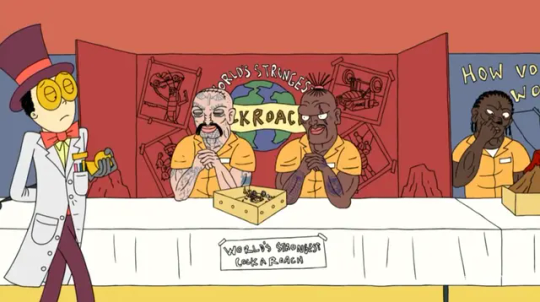
Superjail #7: “Terrorarium” | November 2, 2008 - 11:45PM | S01E06
It’s science fair day at Superjail! Why would there be a science fair in a magical maximum security prison? BECAUSE IT’S FUN! The Warden is unimpressed with the inmates contributions to the fair, preferring his own project: A snowglobe with a tiny jungle inside, which he fills with several inmates by shrinking them down. One lucky survivor will reach the finish line and be granted the opportunity to drink some growth serum, bringing them back to size. Meanwhile, Jarred is bullied by the Warden, Alice, and Jailbot when he tells the Warden that his giant trophy won’t be ready in time for his humility ceremony (which celebrates the Warden’s selfless decision to not give himself a big awards ceremony for winning the science fair).
Some wacky stuff happens with the leftover growth serum. One of the inmates gets some and starts wrecking havoc around Superjail, squishing many of it’s cherished inmates. Jarred also gets some, but it turns him into a Hulk who fights Alice for being mean to him. Eventually the snowglobe breaks and is doused with the serum, unleashing all of the Jumangi-style terrors inside.
This is a solid one, because nearly episode of Superjail is a solid one. A lot of the humor comes from the absurdity of Superjail having a science fair in the first place. The show takes the high-school-ness of it all and runs with it, with the Warden and Co. sitting at a table in the cafeteria and cruelly excluding Jarred. The idea of them having lunch with the inmates is just so gosh darn silly. I can’t stop smiling about it.
This one has a memorable opening sequence with Jacknife getting in a little bit of trouble having sex with a farmer’s daughter, and a nosy UFO which thankfully gets shot down by Jailbot. Jacknife is actually somewhat of a major protagonist here, getting to be one of the shrunk down guys and (spoiler alert) the only one to survive the ordeal. We see him riding the back of a bug, presumably to freedom.
There is also a nod to continuity, like the little girl from the Bunny Love pilot appearing on a milk carton. There’s also flagrant non-continuity, like when we see one inmate get his head torn off by Jailbot early in the episode only to have him return later on, sniffing Gary’s underpants while he sleeps.
EPHEMERA CORNER:
youtube
Bring Out the Dead on Halloween Night (October 31, 2008)
On Halloween, Adult Swim aired a marathon sampling various previously-aired cancelled and never-picked-up shows. Schedule is all thanks to swimpedia, which deserves my thanks for this whole blog, really.
11:00 Welcome to Eltingville: Bring Me the Head of Boba Fett
11:30 Korgoth of Barbaria
12:00 Stroker & Hoop: XXX Wife (a.k.a. Stroke Her and Boob)
12:30 Ranger Smith: Boo Boo Runs Wild
1:00 Harvey Birdman, Attorney at Law: Harvey's Civvy
1:15 Assy McGee: Murder on the Midway
1:30 Minoriteam: Evilfellas
1:45 Perfect Hair Forever: Cat Snatch Fever
2:00 Saul of the Mole Men: IC-CAW
2:15 Space Ghost Coast to Coast: Baffler Meal
3 notes
·
View notes
Text







Mylène Farmer in The Farmer Project (2008)
#french#gifset#my gifs#french side of tumblr#mylène farmer#The Farmer Project 2008#french singer#sci fi#Dégénération#Si J'avais Au Moins
10 notes
·
View notes
Text
Strategic Assessment of the Industrial Starch Market: Market Size, Share, Growth Projections
The global industrial starch market size is estimated to reach USD 197.4 billion by 2030, registering to grow at a CAGR of 8.1% from 2025 to 2030 according to a new report by Grand View Research, Inc. The increasing consumption of convenience food products, coupled with the growth of the pharmaceutical and paper industry, is anticipated to augment the demand for industrial starches.
Industrial Starch Market Report Highlights
The food & beverage segment accounted for the largest share of 57.7% in 2024 due to the extensive use of starch as a thickening, stabilizing, and gelling agent in various processed food products.
The corn segment held the largest market share of the global industrial starch market in 2024 due to corn's high yield, versatile applications, and well-established supply chains. Corn starch is widely utilized in food products, pharmaceuticals, and industrial applications, making it a staple ingredient in many sectors.
The native starch and starch derivatives & sweeteners segment dominated the global industrial starch market in 2024. Native starch, extracted from sources such as corn, potato, and tapioca, is widely used in food processing, textile manufacturing, and paper production due to its natural thickening and stabilizing properties.
North America dominated the global industrial starch market with a revenue share of 48.6% in 2024 due to the high demand for starch in various industries, such as food and beverages, paper, and pharmaceuticals.
For More Details or Sample Copy please visit link @: Industrial Starch Market Report
The packaged food industry is witnessing rapid growth on account of the changing eating habits of consumers. Factors such as long working hours, increasing young working population, and convenient access to packed food with a rising number of large retail marts have contributed to the changing lifestyles of consumers. This trend has been boosting the growth of the food processing industry, thereby positively impacting the market growth.
Governmental initiatives aimed at supporting the international trades and local production output of food and beverage products are further expected to support the industry growth. For instance, the government of Saudi Arabia introduced two initiatives worth USD 692.10 million each, post-COVID-19, for facilitating food imports and supporting the local farmers. European Commission passed a regulation (EC) No. 1333/2008, intended for the fortification of additives in the domestic food and beverage industry.
Players have been focusing on the development of starches providing enhanced texture and mouthfeel. Rising consumer preference for healthy, low fat, and low sugar products has impelled players to develop innovative product ranges with additional functionalities. For instance, in March 2021, Ingredion launched ULTRA-TEX 1311 modified potato starch. This starch can be used as an alternative to oil providing better sensory properties, and thereby suitable to be used in low-fat, reduced-fat, keto-friendly, and plant-based food applications.
List of Key Players in Industrial Starch Market
Cargill, Incorporated
Archer Daniels Midland Company
Ingredion Incorporated
Tate & Lyle PLC
AGRANA Beteiligungs-AG
Grain Processing Corporation
Roquette Frères
Tereos Group
Royal Cosun
Altia Industrial
Global Bio-chem Technology Group Company Limited
#IndustrialStarch#StarchIndustry#StarchMarketTrends#ModifiedStarch#NativeStarch#CornStarch#TapiocaStarch#PotatoStarch#StarchApplications#FoodGradeStarch#TextileIndustry#PaperAndPackaging#AdhesivesAndBinders#BioBasedProducts#SustainableStarchSolutions
0 notes
Text
Nanao Sakaki (1923-2008) was not a Kyoto writer, but a wandering poet who belonged to everywhere and nowhere. By all accounts he led a remarkable life and wrote remarkable poems. Some folks in Kyoto had the pleasure to know him, particularly Ken Rodgers who accompanied him on a tour to Australia. Thanks to Ken for supplying the piece below by Robert Lee, which first appeared in the Kyoto Journal.
***************************** Extracted from Robert Lee’s tribute to Nanao Sakaki ‘Transnational Poet Wanderer’ in Kyoto Journal, no. 78, p.127ff;
There was the first meeting with Snyder and Ginsberg in Kyoto in 1963 and then Snyder’s invitation to him to visit America in 1968 (California and the West Coast of mountain and ocean, Manhattan and Greenwich Village). Subsequent visits include poetry readings with Waldman, Ginsberg, and others, notably at Naropa in 1981. In June 1988 he asked Ginsberg, Snyder, McClure and Waldman for help in raising money to protect the blue coral reef in Ishigaki-jima against becoming a new airport landing-strip. Their poetry reading in San Francisco served as publicity and a fund-raiser. Sakaki’s message to this Beat consortium he included in his Japanese collection CHIKYU B (1989), with a translation into English under the title “Save Shiraho’s Coral Reef” in Nanao or Never (“this Kamikaze project” he calls the planned landing strip).
In an interview with Trevor Carolan, Sakaki explained very succinctly what kind of Zen he adheres to: “ Most Zen is uninteresting to me …It’s too linked to the samurai tradition – to militarism. This is where Alan Watts and I disagreed: he didn’t fully understand how the samurai class with whom he associated Zen were in fact deeply Confucian: they were concerned with power. The Zen I’m interested in is China’s Tang dynasty variant with teachers like Lin Chi. This was non-intellectual. It came from farmers—so simple. Someone became enlightened, others talked to him, learned and were told, Now you go there and teach; you go here, etc. When Japan tried to study this it was hopeless, the emperor sent scholars, but with their high-flown language and ideas they couldn’t understand.” (Nanao or Never).
************************
The following is taken from this webpage: http://www.cuke.com/dchad/writ/Japan%20stories/here%20and%20nanao.html
Nanao’s reputation spread and in the sixties when Allen Ginsberg went to Kyoto to visit Gary Snyder, they were told they had to meet Nanao so they did and they all became fast friends and they invited him to go to America which he did. He spent about ten years in America – in San Francisco and New Mexico and in the mountains and desserts. A friend of mine who knows Nanao says that Nanao walked from New York to California and back and forth a number of times and up to Alaska and so forth. All the walking stories I’ve heard about Nanao seem to me to add up to more miles than one could cover in a lifetime. But whatever he’s walked, it’s been one whole heck of a lot.
Folks at the SF Zen Center got to know Nanao because he never had a place of his own or any money so one of the communal houses near Zen Center would take him in as an honored guest. But he just wrote poetry and philosophized and didn’t tend to do the dishes so, after a while, he’d be passed on to another Zen Center house or hippy commune. And he’d write poetry and publish books and go to events like be-ins and concerts. He didn’t always get his way. Kyokes in Kyoto was working at an environmental center on Yoshida mountain by the Yoshida shrine on the West side of the city – the same place where landscaper and Nanao buddy Sogyu is now. They were running a little hostel there a few years ago at quite reasonable rates and Nanao showed up and wanted a room for free and thought his name would do for legal tender but she said he’d have to pay like everyone else so he went off and found somewhere else.
“His poems were not written by hand or head, but with the feet. These poems have been sat into existence, walked into existence, to be left here as traces of a life lived for living…” Gary Snyder, Foreword, Break the Mirror
If you have time to chatter Read books If you have time to read Walk into mountain, desert and ocean If you have time to walk sing songs and dance If you have time to dance Sit quietly, you Happy Lucky Idiot [ Kyoto, 1966]
1 note
·
View note
Text
GM Maize imports : A poisoned Chalice for Indian Farmers
The ongoing debate in India revolves around the adoption of genetically modified (GM) and non- GM corn varieties. Now- adays, Corn has become a prized commodity for Indian farmers due to its versatile applications. The government, in par allel, is championing corn as an alternative fuel source, capable of being blended with Ethanol With corn being a signif icant component of live stock is an im- perative to bolster corn.
Production in India according to a recent report in the Indian Economic Times, the revenue of the Indian poultry sector is projected to grow by 10% this year, indicative of positive industry per formance, particularly in output. Concurrently, the livestock segment is witnessing a commend able uptick, contribut ing 4.11% to the Indian total GDP and 25.6% to the total agricultural GDP of the nation. An India maize production report forecasts a Com pound Annual Growth Rate (CAGR) of 1.34% for 2021–31, trailing be hind the consumption growth rate pegged at 1.82% during the same period. Additionally, the proportion of maize al located for animal feed is anticipated to rise to ap proximately 54% by 2031 from the current 51%,
Potentially signally a shift towards
genetically modified crops. Advocates of GM Corn argue that its promo- tion is the sole solution to meet the surging de- mand for corn in India. With ethanol producers fiercely vying for maize supplies, the poultry in dustry, heavily reliant on maize for feed, has urged the Union Government to permit the import of genetically modified maize and soy meal Fur thermore, it advocates for the introduction of high-yielding GM seeds to enhance productivity nationwide. While sup porters claim that genet ically modified crops can solve immediate farming problems, closer exam ination uncovers many worries that need to be carefully thought about. GM corn does not direct ly augment yields, by rather tackles short-term pest-related issues, pro viding a temporary boost to productivity. However, is GM Corn
the exclusive remedy India’s maize demand surge? Before hastily endorsing it as the sole option, ought we not assess past experiences such as that of BT cot ton in India? GM Cotton was introduced in India in the 2002–03 season, and by 2007–08, nearly 90% of cotton farms in India were under GM Cotton. Afterward, the typical amount of cotton harvested dropped by 23%, going from 554 kilograms per hectare in the fiscal year 2008 to 429 kilograms per hect are in the fiscal year 2024 (an estimated figure). In stark contrast, Bangla desh witnessed a remark- able surge in cotton yield during this period, from 263 Kgs/ha to 737 Kgs/ha, The adoption of Hybrid BT cotton in India has led to a yield plateau, escalat ing production costs, and diminished productivity, resulting in decreased farmer revenues, cor related with heightened
behind this de dine remains unclear, In European countries, governments are promot ing non-GM corn and have banned GM Corn, While GM seeds offer traits like pest resistance and herbicide tolerance, they often entail higher costs and uncertainties regarding market accep tance. Non-GM maize presents an alternative that reduces reliance on expensive GM technolo- Ry potentially enhancing the economic viability of farming operations. European countries, in particular, impose strin gent regulations on GM crops, creating lucrative opportunities for farm ers producing non-GM maize. Moreover, niche markets seeking natural or organic products often favour non-GM maize, enabling farmers to cater demands and command premium prices. In an era where food transparency and traceability are par- amount, non-GM status serves as a selling point for farmers, enhancing their market competi tiveness. Recently, Mex ico has also decided to han genetically modified corn, as reported in the news. According to an article published by Lucy Sharratt, Coordinator of the Canadian Biotech nology Action Network, a project of Make Way Charitable Society, Mex ko’s restrictions on GM corn aim to safeguard the integrity of native corn from GM contamination and to protect human health. the Canadian Biotechnology Action Network is a large net work of farmers and en vironmental groups that has been monitoring the. use of genetically modi fied organisms (GMOs) for over 15 years. As per them, their research con- tinues to uncover indica- tors of potential harm to humans from consuming GM insect-resistant corn. Most GM corn plants are genetically modified to kill insect pests, express ing a toxin from the soil bacteria Bacillus thuring- iensis (Bt), known to harm the guts of specific types of insects but not others. Farmers have long utilized Bt as a spray to combat pests, but the Bt toxins in GM crops dif fer in structure, function, and biological effects. Indeed, peer-reviewed studies across the scien- tific literature persistently find that Bt toxins in GM. plants can harm insects (spiders, wasps, lady- bugs, and lacewings, for example) that are not the intended targets.
0 notes
Text
MaryJanes Farm Magazine
MaryJane Farm is an organic-focused lifestyle magazine based on farm life with Mary Jane. The magazine began in 1996 as a mail-order catalog. Later editions included gardening articles, recipes, farmer bios, homemaking projects, photography, and essays. In 2008, Butters partnered with Belvoir Media Group to re-launch the magazine as a bi-monthly. The magazine also operates a website to sell its product lines to readers. Marketed items include dried foods, products for the home and garden, crafting supplies, clothing, and household goods.
MaryJane Farm magazine inspires people to living closer to their land and towards organic farming. Readers can find detailed guides on growing their own food, from vegetables and fruits to herbs and flowers. Cooking and preservation are also major themes in this magazine. This magazine inspires people to cook with fresh ingredients like soup with fresh vegetables. Basically MaryJane Farm magazine is about celebrating the living of a farming spiritual girl. The magazine covers a wide array of topics, including organic farming, gardening, cooking, crafting, and natural health, offering a holistic approach to sustainable living.
Crafting is another integral part of this magazine. This magazine also provides inspiration and zeal to their readers in many DIY products that encourages creativity. As MaryJane related to the organic farming it also offers advice on herbal remedies, natural beauty products. This introduce readers to tea leaves which are good for skincare products and knowledge of well being in natural and sustainable way. Enjoy this interesting magazine and order at Magsstore.com. If you are looking for a gift or your own reading to learn something, please visit Magsstore where great discounts are available. Subscribe today to grab this opportunity to get one-year full year subscription at reasonable price.
0 notes
Text
Empowering Farmers, Nurturing Autonomy: Non-GM Breeding for Agricultural Self-Reliance

The ongoing discussion in India centers on the choice between adopting genetically modified (GM) and non-GM corn varieties.
Nowadays, Corn has become a prized commodity for Indian farmers due to its versatile applications. The government, in parallel, is championing corn as an alternative fuel source, capable of being blended with Ethanol.
With corn being a significant component of livestock feed, there is an imperative to bolster corn production in India. Advocates of GM Corn argue that its promotion is the sole solution to meet the surging demand for corn in India.
With ethanol producers fiercely vying for maize supplies, the poultry industry, heavily reliant on maize for feed, has urged the Union Government to permit the import of genetically modified maize and soy meal. Furthermore, it advocates for the introduction of high-yielding GM seeds to enhance productivity nationwide.
While supporters claim that genetically modified crops can solve immediate farming problems, closer examination uncovers many worries that need to be carefully thought about. GM corn does not directly augment yields; rather, it tackles short-term pest-related issues, providing a temporary boost to productivity.
However, is GM Corn the exclusive remedy for India’s maize demand surge? Before hastily endorsing it as the sole option, ought we not to assess past experiences, such as that of BT cotton in India? GM Cotton was introduced in India in the 2002-03 season, and by 2007-08, nearly 90% of cotton farms in India were under GM Cotton.
Afterward, the typical amount of cotton harvested dropped by 23%, going from 554 kilograms per hectare in the fiscal year 2008 to 429 kilograms per hectare in the fiscal year 2024 (an estimated figure). In stark contrast, Bangladesh witnessed a remarkable surge in cotton yield during this period, from 263 Kgs/ha to 737 Kgs/ha.
The adoption of Hybrid BT cotton in India has led to a yield plateau, escalating production costs, and diminished productivity, resulting in decreased farmer revenues, correlated with heightened farmer distress. The rationale behind this decline remains unclear. In European countries, governments are promoting non-GM corn and have banned GM Corn. While GM seeds offer traits like pest resistance and herbicide tolerance, they often entail higher costs and uncertainties regarding market acceptance.
Non-GM maize presents an alternative that reduces reliance on expensive GM technology, potentially enhancing the economic viability of farming operations. European countries, in particular, impose stringent regulations on GM crops, creating lucrative opportunities for farmers producing non-GM maize.
Moreover, niche markets seeking natural or organic products often favour non-GM maize, enabling farmers to cater to specialized consumer demands and command premium prices. In an era where food transparency and traceability are paramount, non-GM status serves as a selling point for farmers, enhancing their market competitiveness.
Recently, Mexico has also decided to ban genetically modified corn, as reported in the news. According to an article published by Lucy Sharratt, Coordinator of the Canadian Biotechnology Action Network, a project of MakeWay Charitable Society, Mexico’s restrictions on GM corn aim to safeguard the integrity of native corn from GM contamination and to protect human health. the Canadian Biotechnology Action Network is a large network of farmers and environmental groups that has been monitoring the use of genetically modified organisms (GMOs) for over 15 years. As per them, their research continues to uncover indicators of potential harm to humans from consuming GM insect-resistant corn.
Most GM corn plants are genetically modified to kill insect pests, expressing a toxin from the soil bacteria Bacillus thuringiensis (Bt), known to harm the guts of specific types of insects but not others. Farmers have long utilized Bt as a spray to combat pests, but the Bt toxins in GM crops differ in structure, function, and biological effects. Indeed, peer-reviewed studies across the scientific literature persistently find that Bt toxins in GM plants can harm insects (spiders, wasps, ladybugs, and lacewings, for example) that are not the intended targets.
India is excelling in Maize production while maintaining non-GM status. Many districts in Andhra Pradesh & Bihar that cultivate non-GM corn match the yield of US GM corn at ~10 tons/ha. If other corn-growing areas in India emulate the agronomical practices of Andhra Pradesh, all-India corn production would reach 65 million tons from the present 33 million tons. There is no imperative to introduce GM corn in India to cater to the burgeoning needs of the poultry and fuel sectors (ethanol). India’s maize production growth rate far surpasses the global average.
To conclude, we should prioritize the welfare of our farmers and explore avenues to enhance their economic conditions, while also safeguarding our biodiversity, environment, and human health. Therefore, it is prudent to exercise caution while promoting GM corn in India, although we possess the capability to attain self-sufficiency by promoting hybrid non-GM seeds.
0 notes